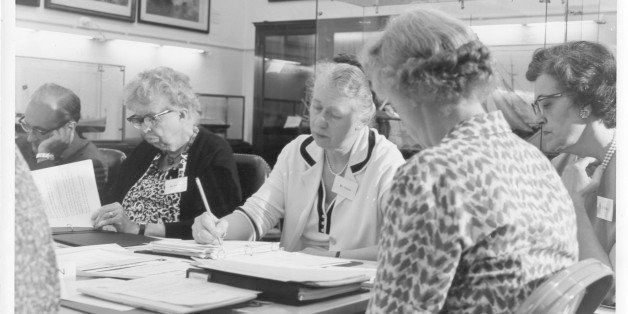
How far have women really come? Jennifer Lee's new documentary, Feminist Stories From Women's Liberation: 1963-1970, is aiming to reopen a conversation on feminism through a reexamination of the movement's history. Shining a light on the grassroots women who had less media visibility, Lee traces the fight for rights that now appear to once again be in danger. She also exposes the fissures within the movement, which continue to play out today.
The motivation for her almost decade long journey of inquiry? Someone whispered to her, "Are you a feminist?" She felt compelled to answer, in a hushed tone, "Yes."
As the onscreen narrator and tour guide of a very tumultuous seven years, Lee introduces the topic with some street interviews on the word "feminist." One youngish woman tells her, "The word has become way overblown... so I don't want to be identified with it." Lee then states her reason for the film, "When we whisper the word feminist, we reject the great women's liberation movement." Her film yields a "complex and multilayered" history meant to serve as a way to inform her daughter and future generations of girls of the struggle that preceded them.
Lee begins her story with World War II -- or what she terms, "life before the movement." She explains how women joined the war effort by working in industries that supported American troops. They received full childcare at no cost, but when the forces came home, those women were politely told to return to their homes.
In setting up her story, Lee gives certain events in a timeline. However, there is much overlap and fluidity as the civil rights movement, the left-wing student movement and the anti-war movement intersect. A major commonality in all these sectors was that despite the tremendous amount of work that women were doing on the ground -- many in leadership positions -- their ideas and calls for gender equality were consistently pushed aside.
Lee names The President's Commission on the Status of Women (1961-1965) as the spark that ignited the women's movement. Esther Peterson, the Assistant Secretary of Labor under President Kennedy, was behind the initiative, and Eleanor Roosevelt served as the chairperson. They pored over data, and what they found "radicalized" them.
Meanwhile, Betty Friedan, who had lost her job when she became pregnant with her second child, penned The Feminine Mystique. It posited that the college education young women had received had made them question their roles as "homemakers." Of course, this only related to a narrow sector of the female population. African-American women and those who had no choice but to work in order to support themselves or their families were missing from that demographic. Yet, the questions raised melded with an advancing post-war realization that "society had to change." Problems were starting to become named; the status quo for many sectors in American society was being challenged.
Many of the women interviewed, both black and white, came out of an involvement in the Student Nonviolent Coordinating Committee (SNCC). While fighting for racial justice, they came to see that the needs of women had to be part of the agenda as well. Ella Baker, Mary King and Casey Hayden all pushed that concept. King and Hayden wrote the paper "Sex and Caste: A Kind of Memo" that became one of the first manifestos of the women's movement. It was disseminated not by email but rather hand-to-hand.
Using the civil rights template of taking the law at face value, there was a push to get action from the Equal Employment Opportunity Commission (EEOC). Rep. Martha Griffiths (D-MI) introduced an amendment to make sure that discrimination on the basis of gender was included in Title VII of the 1964 Civil Rights Act. Ironically, in the first year of EEOC, 33.5% of the complaints lodged were from women (think stewardesses). Pauli Murray pushed on job ads discrimination--still segregated by gender at the time. Ironically, it was while working at the EEOC that Anita Hill was, allegedly, sexually harassed by Clarence Thomas.
A shift began, with a move to create an organization, like the NAACP, that could advocate for women. The National Organization for Women (NOW) was founded in 1966 with Betty Friedan and Paulie Murray at the helm. Friedan wrote an initial mission statement and Murray added "a full scope of human rights" to the verbiage.
Lee carefully constructs how the movement splintered. Just as male members of the civil rights and anti-war movements wanted to promote their ideas and agendas, with less regard for women's issues, Friedan sought to shuffle lesbians out of the picture -- for fear that it would "damage" wider acceptance of the movement. There was also the prime issue that many white middle-class women believed that their perceptions of gender inequality and issues were the universal point of view.
Many of the women interviewed were primary players in getting the movement up and running. Included were: Jeanette Rankin, Ti-Grace Atkinson, Kate Millet, Aileen Hernandez. Some are now familiar names in politics, media and labor -- such as Rep. Eleanor Holmes and Robin Morgan.
Ironically, it isn't until the last part of the film that a figure -- often considered synonymous with feminism -- is introduced at length. She appears in conjunction with the story about the 1969 New York City hearing on abortion. The panel was comprised of nine men and one nun. The Redstockings engaged in an action where they interrupted the proceeding with a "speak out." Gloria Steinem was there as a reporter covering the event. It was her "aha" moment.
Those "Mad Men" days may seem far away; however, Lee's history reminds us that women's fight for equal justice, whether from the government or from each other, is far from over. I reached out to her to get insights into what parallels she has drawn to current situations.
Q: The racial divide in feminism does not seem to have reached any concrete form of resolution. This was evidenced in the recent Twitter "conversation," #SolidarityIsForWhiteWomen. What are your thoughts?
A: As I made the film I saw how numerous the contributions were from women of color. This is why the women's liberation movement needs to be remembered and studied. Women like Pauli Murray were instrumental to the formation of NOW. We don't fully recognize the contributions of Betita Martinez and Frances M. Beal. As I listened to these women talk to me, I realized that women of color fully contributed to the women' s movement and the women's movement needs to be remembered as a movement by and for all women.
Q: You made it clear in the film that Gloria Steinem was preceded by a lengthy line of women fighting in the trenches and at the grassroots level. Did you pick up on any anger or resentment that she became the media face of feminism to so many? Do you think that your film will be able to resurrect the contributions of the many women who were in the Feminist space since the early 1960s?
A: I didn't pick up any anger or resentment, just a need to articulate the fact that so many women came before. Yes, I think my film resurrects the contributions of the women in the early feminist movement. It is exciting to see so many people, upon seeing the film, become so energized by these early women who fought so hard before there was a formalized "women's movement." This is inspiring to people. What became more apparent to me while making the film is that movements are started by people -- not leaders. In our country, we forget this. I think that is because we have a strong media presence that tends to frame an event or a movement in terms of its leaders. This is something that holds us back because people think that they can't make change as an individual, yet that is always how movements start... through people.
Q: Are you hopeful that the film will become part of an educational outreach through your partnership with the National Center for History in the Schools?
A: I am very hopeful that my film will translate into classrooms. I saw it happen in a girls middle school in Denver recently. It was a full classroom of 11 to 14-year-old girls who were excited about the information in the film. They were shocked at the stories by Eleanor Smeal and Congresswoman Eleanor Holmes Norton on what life was like for women before the women's liberation movement. It brought the women's movement home to them. The women's liberation movement is a vital part of American history. Teaching it will help girls see the word 'feminist' as a positive word.
